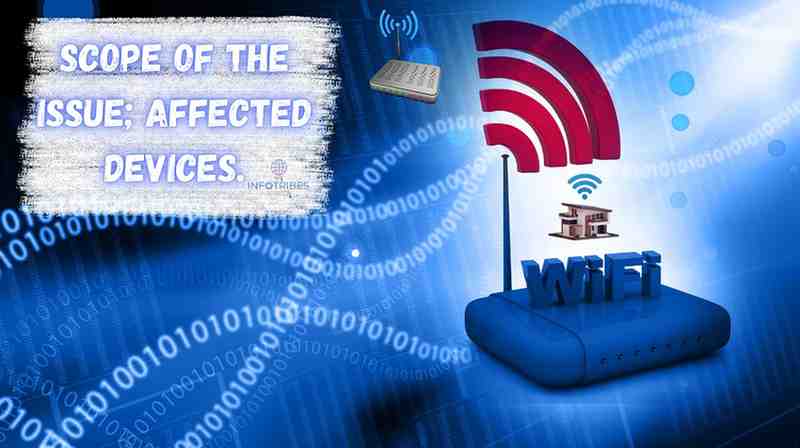Fast forward to our wireless connected era, the security of Wi-Fi networks and devices is critical. From smart homes and retail to corporate infrastructures, Wi-Fi is everywhere. It’s, however, a prime target for cyber criminals and malicious actors, due to its ubiquity. As I mentioned earlier, recently a huge Wi-Fi vulnerability, CVE-2024-41992 has been discovered which has caused a surge of excitement in the security community around how easy it is to exploit wireless networks.
Understanding the Vulnerability: CVE-2024-41992
The Nature of the Threat
CVE-2024-41992 is a vulnerability in the Wi-Fi Test Suite (the Wi-Fi component for testing APIs), and at its core this security concern. The Wi-Fi Alliance developed this suite, which is a set of full featured tools to test Wi-Fi components and Wi-Fi devices. Given this, the scope of the exploitation for this flaw is particularly alarming.
Vulnerability Technical Breakdown
An unauthorized local attackers execute arbitrary code with elevated privileges vulnerability, CVE-2024-41992 exists in affected devices. In simpler terms, if you could get root access to a router or any Wi-Fi based device, you now so effectively and easily have the ‘master key’ of a building; in principle, anyone could take control of that compromised device almost as they wish.
The Mechanics of Exploitation
The Wi-Fi Test Suite uses a command injection vulnerability that the exploit leverages to exploit. An attacker can write specially designed packets and illuminate to some vulnerable device so that the system will run arbitrary commands with root privileges. And this method of attacking is particularly insidious because it bypasses normal authentification process and even a user, who has no account, can freely exploit **Wi-Fi vulnerability CVE-2024-41992** and gain access at high levels.

Scope of the Issue; Affected Devices.
Arcadyan Routers: The Known Victimsb
The Wi-Fi vulnerability CVE-2024-41992 is present in the Wi-Fi Test Suite and is present, specifically, in Arcadyan FMIMG51AX000J routers. Any of these devices have susceptible code from the Wi-Fi Alliance and are particularly vulnerable. It’s important, as Arcadyan is a big manufacturer of wireless devices, and supplies the parts to dozens of well-known brands.
Potential for Wider Impact
- The discovery of this Wi-Fi vulnerability, CVE-2024-41992 in commercial router deployments raises several concerns:
- Unintended Deployment: The Wi-Fi Test Suite is not intended for use in production networks, but was encountered on commercially sold routers.
- Unknown Scope: But for now, it’s possible other router models or Wi-Fi devices could also be affected, though that hasn’t been determined.
- IoT Vulnerability: With the growing Internet of Things ecosystem, other devices outside of traditional router could be in danger if products in the vulnerable Wi-Fi Test Suite are added.
You Can Also Read: The 2024 Permiso Report titled Identity Security Revolution: That’s What the Time for an Interactive Breakthrough Is
Home and Business User Implications
The presence of Wi-Fi vulnerability CVE-2024-41992 in commercial products raises significant concerns for home and business users alike:
- Home Networks: Everything from personal data, smart home devices and daily internet usage could be put at risk.
- Small Businesses: Data sensitive to business information is at risk on local networks.
- Enterprise Environments: Very large networks could be interrupted if devices are vulnerable.
Technical Details of the Exploit as a Penetration Try.
Command Injection: The Core of the Vulnerability
CVE-2024-41992 at its base is a command injection vulnerability. This occurs when a program logically incorporates user-supplied data into a command that the system executes without sanitizing it. In this particular case, while Wi-Fi Test Suite isn’t failing to claim it is validating input correctly here (as boolean operations rely on legacy tools like bash and cat), it’s failing to do so at all; malicious commands are injected and successfully executed with root privileges.
Proof of Concept: From Theory to Practice
On top of that, a proof of concept (PoC) exploit for Wi Fi vulnerability CVE 2024 41992 has been made publically available. The researcher “fj016” developed it, and it shows the practical feasibility of exploitation in real world scenarios. The PoC lowers the barrier of attack, however, it gives attackers a blueprint on which to exploit this vulnerability.
Exploitation Process
The process for exploiting Wi-Fi vulnerability CVE-2024-41992 generally involves:
- Being able to find a vulnerable device on the network at all.
- Sending them packets with malicious commands that they will run.
- On sending these packets to device.
- They are processed by the Wi-Fi Test Suite without validation meaning root privileges are then exported via command execution on the host system.
Timeline and Disclosure
There is Discovery and something in there called Initial Reporting.
The journey of Wi-Fi vulnerability CVE-2024-41992 from discovery to disclosure followed a responsible timeline:
- April 2024: Independent researcher “fj016” discovered this.
- Immediate Reporting: It was reported to the Wi-Fi Alliance immediately.
- Verification: So manufacturers and the Wi-Fi Alliance started looking into it.
Public Disclosure
The public became aware of **CVE-2024-41992** through announcements:
- August 2024: SSD Secure Disclosure published preliminary information.
- Cybersecurity Reports: The other tech media outlets and other organizations covered.
- CERT/CC Advisory: A fairly easy to exploit security weakness was announced by the CERT Coordination Center, which has received wide attention.
Responsible Disclosure Importance
The significance of responsible disclosure in cybersecurity is emphasized by this timeline:
- The patches can also be developed and tested by affected parties.
- It helps to stop eventually exploitation, pending a patch.
- The collaborative nature of cybersecurity between researchers, manufacturers and security organizations is illustrated by the process.
Potential Impact and Risks
Comprehensive Device Control
Exploiting Wi-Fi vulnerability CVE-2024-41992 grants full administrative control, allowing a range of malicious activities:
- System Access: Attackers can read, modify and delete device data.
- Network Manipulation: Devices are compromised and can be used as gateways to do harm through other network devices.
- Persistent Access: Backdoors installed: Attackers may install backdoors — software which lets them access your computer even after you install a patch to fix the problem.
Potential Consequences
The ramifications of CVE-2024-41992 extend far beyond basic device compromise:
- System Setting Modifications: Attackers can ever alter system configurations.
- Service Disruption: It interrupts critical services.
- Device Resets: A total reset can also unset service and will lose data.
- Data Compromise: The data could be exposed sensitive data.
- Service Loss: Network interruptions can last so long that they can affect personal or business operations.
- Botnet Recruitment: The devices could also be part of a botnet for bad activity.
- Reputation Damage: A businesses that produces an affected product may harm his reputation.
Mitigation Strategies
Immediate Actions for Vendors
In the absence of an official patch, CERT/CC has recommended two approaches for vendors affected by Wi-Fi vulnerability CVE-2024-41992
- Complete Removal: Serial firmware upload that flashes Wi-Fi Test Suite from production devices free of the vulnerability.
- Version Update: Updating the suite to at least version 9.0 now includes security improvements.
Steps for Network Administrators.
Network administrators should take several steps:
- Inventory Check: Find out who have potentially vulnerable device.
- Firmware Updates: Now is also a good time to apply available firmware updates.
- Network Segmentation: Isolate vulnerable devices.
- Monitoring: Increase the network activity monitoring.
- Access Control: Enhance the access and the authentication.
Policies for Home Users are recommended:
Home users are also advised to follow these steps:
- Router Updates: Check for and apply updates.
- Change Default Settings: Change passwords, and disable remote management if you don’t require it.
- Network Monitoring: Keep an eye out for any strange looking network behavior.
- Consult IT Professionals: If you need to contact router manufacturers.
More broadly, IoT security has broader Implications and not just limited to the IoT but, even then, the security aspects shared with all kinds of solutions across the technology spectrum can be applied to the IoT.
Lessons for the Industry
The discovery of Wi-Fi vulnerability CVE-2024-41992 is a stark reminder of IoT security challenges:
- Testing Tools in Production: It’s not a good idea for testing suites to deploy in production devices.
- Supply Chain Security: Every supply chain need to be secured.
- Rapid Response: Efficient patching mechanisms are needed for the industry.
Future of IoT Security
This incident may inspire positive security advancements:
- Enhanced Firmware Validation: Validations processes improved.
- Improved Update Mechanisms: Automated user friendly update systems.
- Security-First Design: Security in product design.
- Standardization: Demand for standard protocols of security in IoT.

Cybersecurity Research — The Role of
Independent Researchers Importance
The discovery of CVE-2024-41992 underscores the role of independent security experts:
- Fresh Perspectives: Opinions in security analysis that are unique to folks.
- Motivation: Security work that does not have commercial interest is done by many researchers.
- Diverse Skill Sets: Vast array range of expertise and methodologies.
Research Cooperation Between Researchers and Industry
This incident also demonstrates the value of collaboration:
- Responsible Disclosure: Allows coordinated responses.
- Knowledge Sharing: Vulnerabilities are explained via PoCs.
- Continuous Improvement: The feedback from the researchers is giving them an improved security practice.
Conclusion: Getting Navigated Through WiFI Security Challenges
A reminder that the work to make networked devices secure never ends, the discovery of Wi-Fi vulnerability CVE-2024-41992 in the Wi-Fi Test Suite. The impact the world has become..
The number of vulnerabilities grows exponentially.
This event highlights the need for ongoing watchfulness, interoperate honesty, aggressive restraint, and the user’s sheer understanding. We can make our way toward seeing a safe digital future by remaining informed, following best practices and supporting research
For more content we’ve posted, follow us on LinkedIn.
